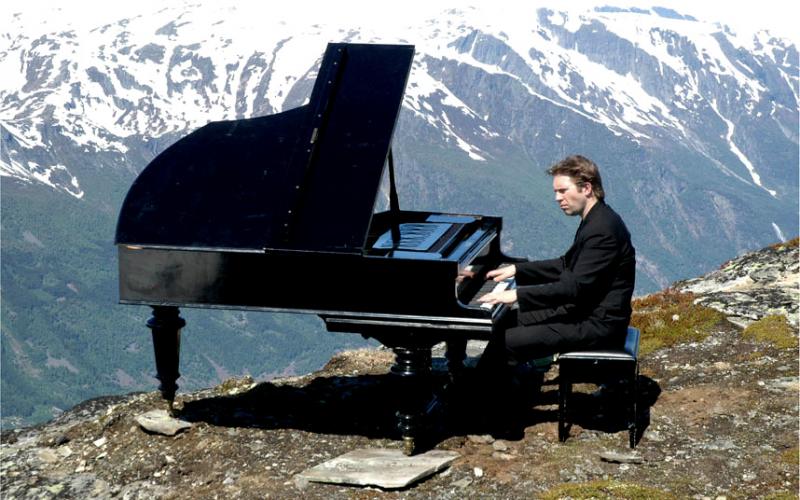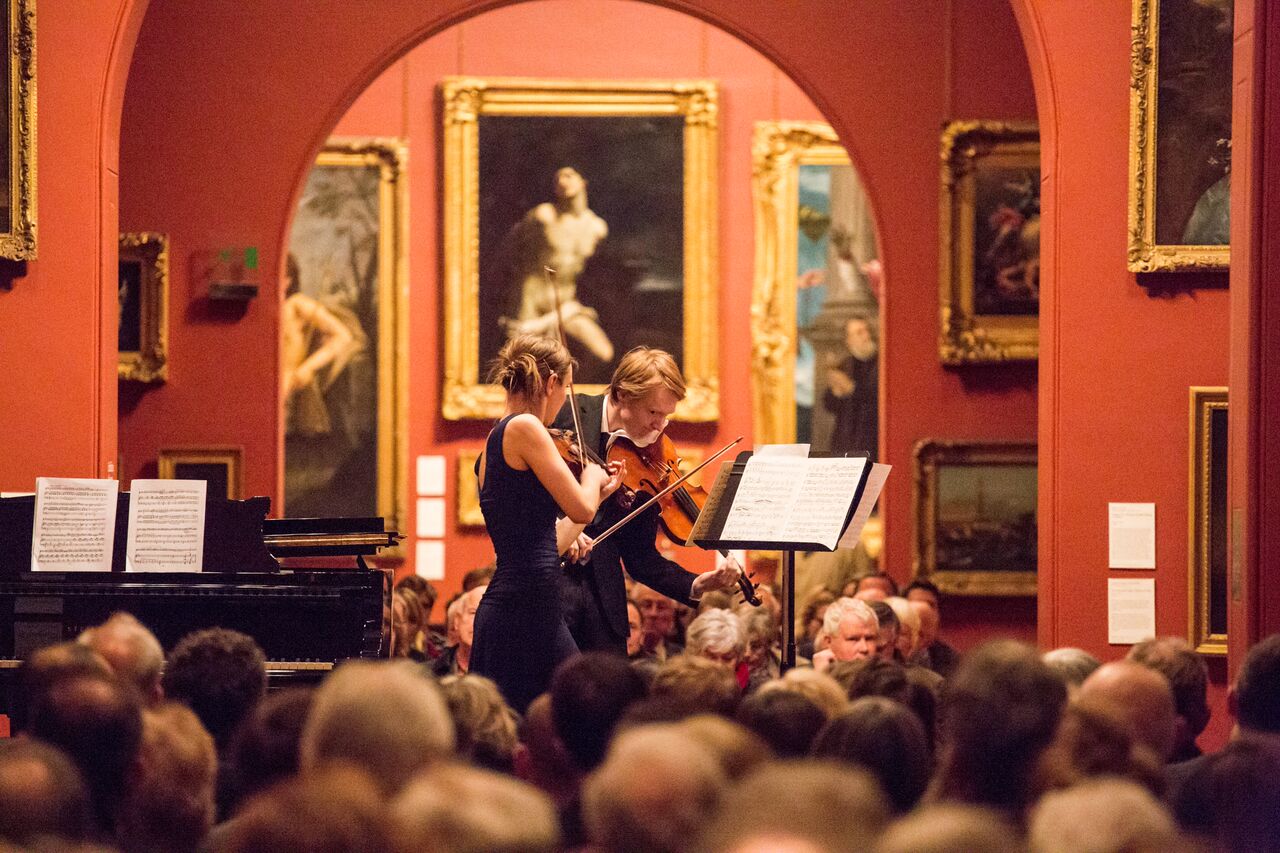Andsnes and Friends 2, Dulwich Picture Gallery | reviews, news & interviews
Andsnes and Friends 2, Dulwich Picture Gallery
Andsnes and Friends 2, Dulwich Picture Gallery
More fresh perspectives on Norway, its music and its art

Nature, nationalism, folk culture: the broad themes of Norway’s visual arts map easily onto its music. That has given Leif Ove Andsnes and his colleagues plenty of leeway in planning their musical tributes to the painter Nikolai Astrup.
But the short recital began with familiar fare: Andsnes in Grieg’s Lyric Pieces. The pianist’s touch suited the acoustic, deliberate and clear but never overbearing. Despite the ubiquity of his Grieg recordings, Andsnes is always able to keep this music fresh, with every phrase holding surprises of nuance and dynamic. The short set ended with the rousing Peasant Dance, op. 54/2, the gradual build-up to the climax perfectly paced, the ever-increasing energy seeming to come from within the music itself. That preparation made the climax seem thunderous, but the crystal clarity of the textures, even here, demonstrated how Andsnes was finely gauging his dynamics to the space.
Ringstad again handled the technicalities with ease, with Andsnes offering solid but sympathetic supportViolinist Guro Kleven Hagen brought us forward a century or two with the next work, Classical Brace, written by Klaus Sandvik in 2009. The programme note was frustratingly slight on detail here, saying only that Sandvik is seen as a successor to Arne Nordheim. More useful would have been an explanation of the competing styles within the work. It begins in Hardanger fiddle mode, with unisons, or near unisons, in sustained double-stopping and skittering barriolage. From there it grows into more complex textures, while always maintaining an austere, even icy, tone. In the final passage, the music distills into a Baroque air, perhaps the source of all the ideas up to this point.
Hagen’s performance was committed and assured, affording the long phrases and sustained textures coherence through her broad, even phrasing. The following Romance by Johan Svendsen brought out her more expressive side, the music’s sweeping, romantic textures proving equally amenable to her impressively versatile technique. So too the Norwegian Dance No. 1 of Johan Halvorsen, the virtuosic fireworks taking the programme in yet another unexpected direction. In both works, and for the remainder of the programme, Andsnes took a back seat, accompanying with panache, but rarely even approaching the limelight.

Capricci, by Bjarne Brustad, introduced violist Eivind Holtsmark Ringstad, like Hagen in his early 20s, and a match for her in tone, technique and musical temperament (Hagen with Ringstad in the Dulwich Gallery pictured above by Liv Øvland). The duo for violin and viola calls for one or both instruments to be muted almost throughout, a particularly attractive effect in the gallery acoustic. Brustad’s style tends towards the impressionistic, with long, elegant, and distinctly Norwegian melodies vying with complex colouristic passages for the two instruments. A daring and unusual work, and a perfect choice for the programme.
To conclude, Suite in the Old Style for viola and piano by Christian Sinding. “Old style” here denotes a heavily romantic gloss on the Baroque (the work was written in 1889): Bach via Busoni, or even Stokowski. It is an effective mix, especially in the first movement, where extended virtuosic viola textures are underpinned by Baroque chord sequences and cadences. Ringstad again handled the technicalities with ease, with Andsnes offering solid but sympathetic support.
For an encore: Grieg, who else? A song transcribed for viola and piano. A fitting end to an imaginative and wide-ranging series of concerts. Only two programmes were offered, and both were short. But the musical ground covered here has been impressive, as have the many perspectives and reflections that the concerts have offered on their subject, the work of Nikolai Astrup. One world-class pianist aside, Astrup remains the star attraction here, and the Painting Norway exhibition at the Dulwich Picture Gallery is a real eye-opener. It runs until 15 May. Don’t miss it!
rating
Explore topics
Share this article
The future of Arts Journalism
You can stop theartsdesk.com closing!
We urgently need financing to survive. Our fundraising drive has thus far raised £33,000 but we need to reach £100,000 or we will be forced to close. Please contribute here: https://gofund.me/c3f6033d
And if you can forward this information to anyone who might assist, we’d be grateful.

Subscribe to theartsdesk.com
Thank you for continuing to read our work on theartsdesk.com. For unlimited access to every article in its entirety, including our archive of more than 15,000 pieces, we're asking for £5 per month or £40 per year. We feel it's a very good deal, and hope you do too.
To take a subscription now simply click here.
And if you're looking for that extra gift for a friend or family member, why not treat them to a theartsdesk.com gift subscription?
more Classical music
 Donohoe, RPO, Brabbins, Cadogan Hall review - rarely heard British piano concerto
Welcome chance to hear Bliss’s big-boned concerto alongside better-known British classics
Donohoe, RPO, Brabbins, Cadogan Hall review - rarely heard British piano concerto
Welcome chance to hear Bliss’s big-boned concerto alongside better-known British classics
 London Choral Sinfonia, Waldron, Smith Square Hall review - contemporary choral classics alongside an ambitious premiere
An impassioned response to the climate crisis was slightly hamstrung by its text
London Choral Sinfonia, Waldron, Smith Square Hall review - contemporary choral classics alongside an ambitious premiere
An impassioned response to the climate crisis was slightly hamstrung by its text
 Goldberg Variations, Ólafsson, Wigmore Hall review - Bach in the shadow of Beethoven
Late changes, and new dramas, from the Icelandic superstar
Goldberg Variations, Ólafsson, Wigmore Hall review - Bach in the shadow of Beethoven
Late changes, and new dramas, from the Icelandic superstar
 Mahler's Ninth, BBC Philharmonic, Gamzou, Bridgewater Hall, Manchester review - vision and intensity
A composer-conductor interprets the last completed symphony in breathtaking style
Mahler's Ninth, BBC Philharmonic, Gamzou, Bridgewater Hall, Manchester review - vision and intensity
A composer-conductor interprets the last completed symphony in breathtaking style
 St Matthew Passion, Dunedin Consort, Butt, Queen’s Hall, Edinburgh review - life, meaning and depth
Annual Scottish airing is crowned by grounded conducting and Ashley Riches’ Christ
St Matthew Passion, Dunedin Consort, Butt, Queen’s Hall, Edinburgh review - life, meaning and depth
Annual Scottish airing is crowned by grounded conducting and Ashley Riches’ Christ
 St Matthew Passion, Irish Baroque Orchestra, Whelan, St Patrick’s Cathedral, Dublin review - the heights rescaled
Helen Charlston and Nicholas Mulroy join the lineup in the best Bach anywhere
St Matthew Passion, Irish Baroque Orchestra, Whelan, St Patrick’s Cathedral, Dublin review - the heights rescaled
Helen Charlston and Nicholas Mulroy join the lineup in the best Bach anywhere
 Kraggerud, Irish Chamber Orchestra, RIAM Dublin review - stomping, dancing, magical Vivaldi plus
Norwegian violinist and composer gives a perfect programme with vivacious accomplices
Kraggerud, Irish Chamber Orchestra, RIAM Dublin review - stomping, dancing, magical Vivaldi plus
Norwegian violinist and composer gives a perfect programme with vivacious accomplices
 Small, Hallé, Wong, Bridgewater Hall, Manchester review - return to Shostakovich’s ambiguous triumphalism
Illumination from a conductor with his own signature
Small, Hallé, Wong, Bridgewater Hall, Manchester review - return to Shostakovich’s ambiguous triumphalism
Illumination from a conductor with his own signature
 LSO, Noseda, Barbican review - Half Six shake-up
Principal guest conductor is adrenalin-charged in presentation of a Prokofiev monster
LSO, Noseda, Barbican review - Half Six shake-up
Principal guest conductor is adrenalin-charged in presentation of a Prokofiev monster
 Frang, LPO, Jurowski, RFH review - every beauty revealed
Schumann rarity equals Beethoven and Schubert in perfectly executed programme
Frang, LPO, Jurowski, RFH review - every beauty revealed
Schumann rarity equals Beethoven and Schubert in perfectly executed programme
 Levit, Sternath, Wigmore Hall review - pushing the boundaries in Prokofiev and Shostakovich
Master pianist shines the spotlight on star protégé in another unique programme
Levit, Sternath, Wigmore Hall review - pushing the boundaries in Prokofiev and Shostakovich
Master pianist shines the spotlight on star protégé in another unique programme
 Classical CDs: Big bands, beasts and birdcalls
Italian songs, Viennese chamber music and an enterprising guitar quartet
Classical CDs: Big bands, beasts and birdcalls
Italian songs, Viennese chamber music and an enterprising guitar quartet

Add comment